2024 Bibi 4 Site
Chitose City, Hokkaido
Late to Final Stage Jomon Period (ca. 3,000 years ago)
Communal Burial Complex within New Chitose Airport
The Bibi 4 Site is located within the premises of New Chitose Airport in the southern part of Chitose City. It is situated on the left bank of the Misawa River, which marks the boundary with Tomakomai City, on a south-facing gentle slope at an elevation of 5–20 meters. The site extends from the plateau in the north, across the slope, to the lowlands in the south and even includes the current riverbed. The Misawa River basin is renowned as a repository of archaeological sites, with remains spanning from the Paleolithic period to the Ainu cultural phase concentrated in this region.
Archaeological investigations were conducted in conjunction with the construction and development of New Chitose Airport. These include the surveys conducted between 1976 and 1985 (referred to as the ‘Shōwa investigations’), those associated with the construction of maintenance roads in 1994 and 1995 (referred to as the ‘Heisei investigations’), and, since 2021, excavations related to the expansion of parallel taxiways (the Reiwa Investigations).
These excavations uncovered various burial features from the Late and Final Jomon periods, including pit burials, earthwork burials, and mound burials. Moreover, numerous valuable artifacts, such as animal-shaped clay objects designated as Important Cultural Properties, were unearthed. The findings revealed that the entire site contained a burial area dating from the terminal phase of the Late Jomon to the early part of the Final Jomon, establishing it as one of the most prominent Jomon archaeological sites in Hokkaido.
During the Shōwa investigations, large-scale communal burial features such as earthwork burials and trench burials were identified on the plateau. Notably, earthwork burials are unique to Hokkaido, with outer diameters ranging from several meters to tens of meters. In the same Chitose City, the Kiusu Earthwork Burial Circles, part of the UNESCO World Heritage Site “Jomon Prehistoric Sites in Northern Japan” includes examples with outer diameters as large as 83 meters. In the lowlands adjacent to the Misawa River, mound burials were discovered. These burials did not involve interment in pits but rather employed volcanic ash and other materials to construct burial mounds.
This burial area has yielded animal-shaped clay artifacts designated as Important Cultural Properties. During the Heisei investigations, the slope area between the plateau and the lowlands was examined. Despite the limited survey area, a substantial quantity of pottery and stone tools from the Late and Final Jomon periods was recovered. Notably, a pottery fragment with an owl motif unearthed from the slope area in 1995 (Heisei 7) was found to fit together with a fragment recovered from the embankment burial on the plateau during the 1983 (Shōwa 58) investigations, demonstrating integrated usage of the plateau and slope within the site.
The Reiwa investigations also focused on the slope area, uncovering a significant volume of artifacts, including numerous decorative items such as jade magatama (comma-shaped beads) and clay earplugs (ear ornaments). Additionally, a notable feature of the assemblage was the large quantity of charred animal bone fragments, including those of Hokkaido deer, wild boar, and dogs. Based on these findings, the slope area is considered to correspond to an elevated mound structure associated with ritual and ceremonial activities.
In 2023 (Reiwa 5), ten pit burials containing human remains were identified. This marked the first discovery of multiple pit burials in the slope area of this site. Furthermore, there is potential for these burial zones to extend westward into the excavation area planned for 2024 (Reiwa 6), making the identification of a new burial area a significant development.
The diverse burial forms and practices revealed at this site, represented by features such as earthwork burials and mound burials, are not only significant for understanding burial systems within Hokkaido but also provide valuable case studies for examining mortuary practices in Jomon culture more broadly.
(Fujii Hiroshi)
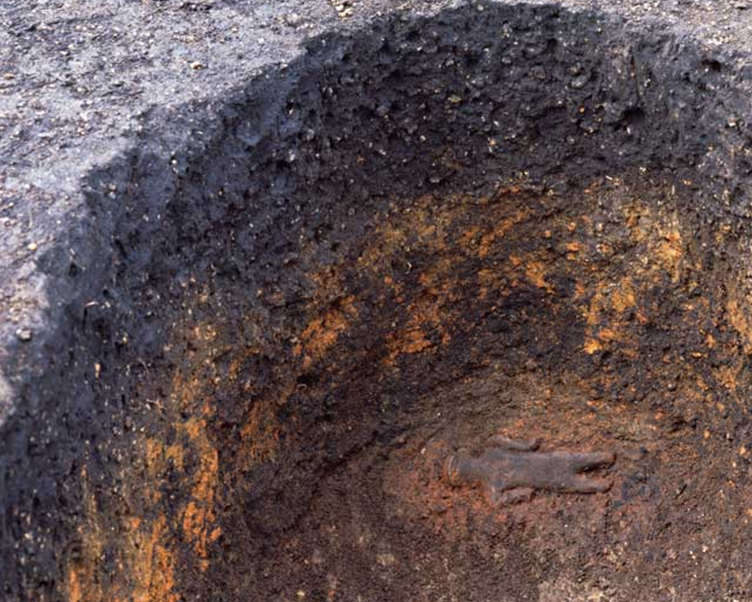
Pit Burial with a Dogū (Clay Figurine) (Shōwa 58 Excavation)

Dogū (Clay Figurine)
Discovered on the floor of a pit burial. It was covered in bengara (red ochre) and found lying face-down. It is considered to be a grave good. The complete preservation of a clay figurine within a burial is fairly rare. Height: 20 cm.

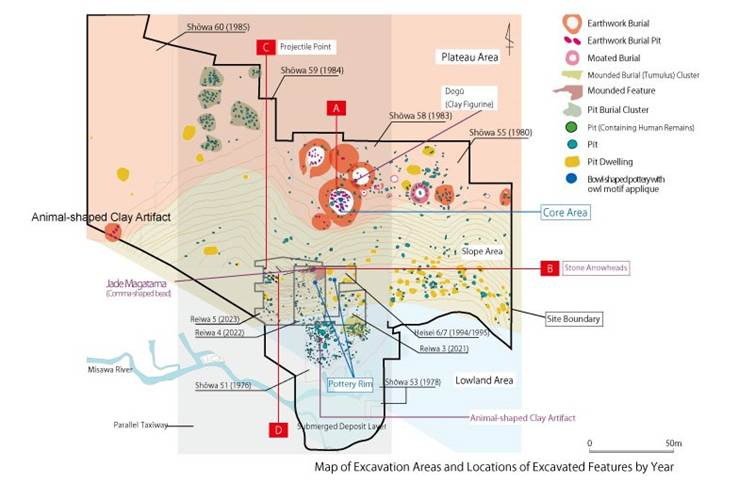
Pit Burial
A burial in which a circular or elliptical hole is dug into the ground to inter a body.
Earthwork Burial & Moated Burial Mound
An earthwork burial (shūteibo) is a type of communal burial site where a circular vertical pit is dug, and the excavated soil is heaped around the perimeter to form an earthen embankment (shown in pale yellow as ‘A’). Burial pits are primarily placed inside this embanked area. This burial type is found exclusively in Hokkaido during the Late Jomon period.
A moated burial mound (shūkōbo) is a burial site where a circular or horseshoe-shaped ditch is dug around the burial area, with burial pits placed inside the enclosed space.
Mounded Burial (Tumulus)
A type of burial where the body is placed in a shallow depression in the ground, and volcanic ash is heaped over it to create a mounded burial. Volcanic ash from Shikotsu Caldera and Mount Eniwa (Eniwa-dake) was used for this purpose. It is believed to have been a collective burial (gassōbo), where multiple bodies were interred together. At the time of excavation, it was referred to as a “tumulus” (funbo).
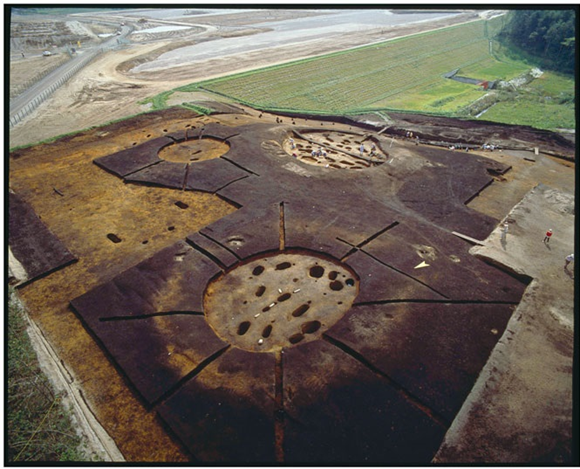
Earthwork Burial Cluster on the Plateau Area (Shōwa 58 Excavation, Upper Right is South)
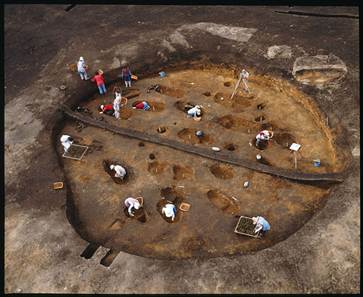
Excavation Status of the Earthwork Burial (Shōwa 58 Excavation)
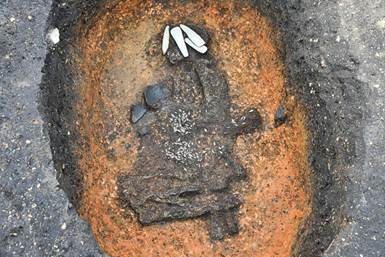
Pit Burial with Stone Axes and Stone Arrowheads as Grave Goods (Reiwa 5 Excavation)